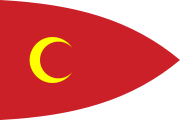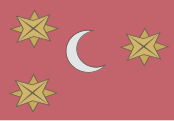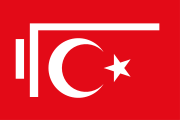Flags of the Ottoman Empire
Last updatedThis article needs additional citations for verification .(June 2010) |
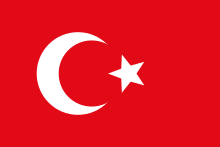
The Ottoman Empire used various flags and naval ensigns during its history. The crescent and star came into use in the second half of the 18th century. A buyruldu (decree) from 1793 required that the ships of the Ottoman Navy were to use a red flag with the star and crescent in white. In 1844, a version of this flag, with a five-pointed star, was officially adopted as the Ottoman national flag. The decision to adopt a national flag was part of the Tanzimat reforms which aimed to modernize the Ottoman state in line with the laws and norms of contemporary European states and institutions.
Contents
- Early flag
- Crescent and Star flag
- Source of the Star and Crescent symbol
- Imperial standards
- Civil ensigns
- See also
- References
- External links
The star and crescent design later became a common element in the national flags of Ottoman successor states in the 20th century. The current flag of Turkey is essentially the same as the late Ottoman flag, but has more specific legal standardizations (regarding its measures, geometric proportions, and exact tone of red) that were introduced with the Turkish Flag Law on 29 May 1936. Before the legal standardization, the star and crescent could have slightly varying slimness or positioning depending on the rendition.
Early flag
Pre-modern Ottoman armies used the horse-tail standard or tugh rather than flags. Such standards remained in use alongside flags until the 19th century. A depiction of a tugh appears in the Relation d'un voyage du Levant by Joseph Pitton de Tournefort (1718). [1] War flags came into use by the 16th century. During the 16th and 17th centuries, Ottoman war flags often depicted the bifurcated Zulfiqar sword, often misinterpreted in Western literature as showing a pair of scissors. [2] the Topkapı Museum exhibits a Zulfiqar flag claimed to have been used by Sultan Selim I (r. 1512–1520). Two Zulfiqar flags are also depicted in a plate dedicated to Turkish flags in vol. 7 of Bernard Picart's Cérémonies et coutumes religieuses de tous les peuples du monde (1737), attributed to the Janissaries and the Ottoman cavalry.
The crescent symbol appears in flags attributed to Tunis from as early as the 14th century ( Libro de conoscimiento ), long before Tunis fell under Ottoman rule in 1574. But the crescent as a symbol also had 14th-century associations with the Ottoman military [3] and millennium-long associations with the city of Istanbul, [4] [5] which became the Ottoman capital after its conquest in 1453. The Spanish Navy Museum in Madrid shows two Ottoman naval flags dated 1613; both are swallow-tailed, one green with a white crescent near the hoist, the other white with two red stripes near the edges of the flag and a red crescent near the hoist. [6]
According to Rıza Nur, sultan Selim I (1512-20) had a white personal flag, while the Ottoman Army flag was red (kızıl bayrak). During Süleyman I's reign (1520-66) the janissaries had a white flag while the timariot cavalry had a red flag. It was used as the Ottoman civic and merchant flag from 1793 to 1923.
- Various Ottoman flags and tughs displayed before the Siege of Szigetvár in 1566
- Plain red banners for the Sultan's retinue. From the Turkish Costume Book by Lambert de Vos, 1574.
- Ottoman flags in a 1581 fresco by Matteo Pérez depicting the Great Siege of Malta
- Zulfikar flag typically in use during the 16th and 17th centuries. The design is a rough approximation of the Zulfikar flag used by Selim I in the 1510s.
- Zulfiqar flag captured during the Battle of Guruslău in 1601
- Coat of arms of Moldavia, c. 1812. As supporters, flags which Sultan Mahmud II (r. 1808–1839) may have granted to Scarlat Callimachi (r. 1806–1819).
Crescent and Star flag
Following the conquest of Constantinople in 1453, the crescent moon and star symbol started being used on Turkic peoples flags. Ottoman flags were originally commonly green, but the flag was defined as red by decree in 1793 and an eight-pointed star was added.[ citation needed ] The red version of the flag had become ubiquitous by the reign of Selim III. [7] The five pointed star did not appear until the 1840s. [8]
With the Tanzimat reforms in the 19th century, flags were redesigned in the style of the European armies of the day. The flag of the Ottoman Navy was made red, as red was to be the flag of secular institutions and green of religious ones. As the reforms abolished all the various flags (standards) of the Ottoman pashaliks, beyliks and emirates,[ further explanation needed ][ which? ] a single new Ottoman national flag was designed to replace them. The result was the red flag with the white crescent moon and star, which is the precursor to the modern flag of Turkey. A plain red flag was introduced as the civil ensign for all Ottoman subjects.
After the foundation of the Republic of Turkey in 1923, the government maintained the last flag of the Ottoman Empire. Proportional standardisations were introduced in the Turkish Flag Law (Turkish : Türk Bayrağı Kanunu) of 29 May 1936.
- A type Standart Flag of the Ottoman Empire
- Army banner with crescent, as depicted in a 1721 illustration to 'Ata'i's Hamse
- "Blue Turks' flag", seen in flag charts c. 1780
- "Turkish Purple flag", also used in 1780s charts
- "Turks Standard", in Bowles's Universal Display of the Naval Flags of all Nations (1783)
- Crescent flag reported during the war with Austria in 1788. This is the reverse side; the horns of the crescent are therefore pointing towards the hoist (the inverse of the later national flag).
- Eight-pointed star flag (after 1844)
- A 19th century Ottoman tugh
Source of the Star and Crescent symbol
It has been suggested that the star-and-crescent used in Ottoman flags of the 19th century had been adopted from the Byzantine. Franz Babinger (1992) suggests this possibility, noting that the crescent alone has a much older tradition also with Turkic tribes in the interior of Asia. [9] The crescent and star is found on the coinage of Byzantium since the 4th century BC [10] and was depicted on Byzantine Empire's coins and shields of Christian warrior saints till the 13th century. [11] Parsons (2007) notes that the star and crescent was not a widespread motive on the coinage of Byzantium at the time of the Ottoman conquest. [12] Turkish historians tend to stress the antiquity of the crescent (not star-and-crescent) symbol among the early Turkic states in Asia. [13]
Imperial standards
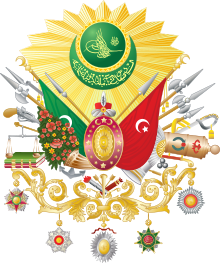
The imperial standard displayed the sultan's tughra, often on a pink or bright red background.
- Imperial Standard of the Ottoman Sultan [15]
- Naval Standard of the Ottoman Sultan
- Standards used by the Ottoman Army in 1900
The standard used by the last Caliph, Abdulmejid II (between 19 November 1922 – 3 March 1924) consisted of a green flag with a star and crescent in white on a red oval background within a rayed ornament, all in white.
- Caliphate Standard of Abdulmejid II [16]
Civil ensigns
- Latin and Albanian Merchant Flag (1453–1793)
- Jewish Merchant Flag (1453–1793)
- Muslim Merchant Flag (1453–1793)
- Roman (Orthodox Christian, Greek) Merchant Flag (1453–1793)
- Ottoman Army, Civic, and Merchant Flag (1512–20; 1520–66; 1793–1923)
See also
Related Research Articles
Byzantium or Byzantion was an ancient Greek city in classical antiquity that became known as Constantinople in late antiquity and Istanbul today. The Greek name Byzantion and its Latinization Byzantium continued to be used as a name of Constantinople sporadically and to varying degrees during the thousand year existence of the Byzantine Empire. Byzantium was colonized by Greeks from Megara in the 7th century BC and remained primarily Greek-speaking until its conquest by the Ottoman Empire in AD 1453.

The fall of Constantinople, also known as the conquest of Constantinople, was the capture of the capital of the Byzantine Empire by the Ottoman Empire. The city was captured on 29 May 1453 as part of the culmination of a 53-day siege which had begun on 6 April.

A crescent shape is a symbol or emblem used to represent the lunar phase in the first quarter, or by extension a symbol representing the Moon itself.

The Ottoman Interregnum, or the Ottoman Civil War, was a civil war in the Ottoman Empire between the sons of Sultan Bayezid I following their father's defeat at the hands of Timur in the Battle of Ankara on 20 July 1402. Although Timur confirmed Mehmed Çelebi as sultan, Mehmed's brothers İsa Çelebi, Musa Çelebi, Süleyman Çelebi, and later, Mustafa Çelebi, refused to recognize his authority, each claiming the throne for himself. This resulted in civil war. The Interregnum would last a little under 11 years, culminating in the Battle of Çamurlu on 5 July 1413, when Mehmed Çelebi emerged as victor, crowned himself Sultan Mehmed I, and restored the empire.

Rumelihisarı or Boğazkesen Fortress is a medieval Ottoman fortress located in Istanbul, Turkey, on a series of hills on the European banks of the Bosphorus. The fortress also lends its name to the immediate neighborhood around it in the city's Sarıyer district.

Every sultan of the Ottoman Empire had his own monogram, called the tughra, which served as a royal symbol. A coat of arms in the European heraldic sense was created in the late 19th century. Hampton Court requested from the Ottoman Empire a coat of arms to be included in their collection. As the coat of arms had not been previously used in the Ottoman Empire, it was designed following this request of Mahmud II, and the final design was adopted by Sultan Abdul Hamid II on 17 April 1882.

The star and crescent is a symbol which is a conjoined representation of a crescent and a star. It is used in various historical contexts, including as a prominent symbol of the Ottoman Empire, and in contemporary times used as a national symbol for some countries, and a recognized symbol of Islam. It was developed in the Greek colony of Byzantium ca. 300 BC, though it became more widely used as the royal emblem of Pontic king Mithridates VI Eupator after he incorporated Byzantium into his kingdom for a short period. During the 5th century, it was present in coins minted by the Persian Sassanian Empire; the symbol was represented in the coins minted across the empire throughout the Middle East for more than 400 years from the 3rd century until the fall of the Sassanians after the Muslim conquest of Persia in the 7th century. The conquering Muslim rulers kept the symbol in their coinage during the early years of the caliphate, as the coins were exact replicas of the Sassanian coins.

Zaganos or Zagan Pasha was an Albanian Ottoman military commander, with the titles and ranks of kapudan pasha and the highest military rank, grand vizier, during the reign of Sultan Mehmed II "the Conqueror". Originally a Christian, who was conscripted and converted through the devşirme system, he became a Muslim and rose through the ranks of the janissaries. He became one of the prominent military commanders of Mehmed II and a lala – the sultan's advisor, mentor, tutor, councillor, protector, all at once. He removed his rival, the previous Grand Vizier Çandarlı Halil Pasha the Younger, amid the fall of Constantinople. He later served as the governor of Thessaly of Macedonia.

Ottoman military band is the oldest recorded military marching bands in the world. Though they are often known by the word Mehter in West Europe, that word, properly speaking, refers only to a single musician in the band. In Ottoman, the band was generally known as mehterân, though those bands used in the retinue of a vizier or prince were generally known as mehterhane, the band as a whole is often termed mehter bölüğü, mehter takımı. In West Europe, the band's music is also often called Janissary music because the janissaries formed the core of the bands.
Çandarlı Halil Pasha, known as the Younger, was a highly influential Ottoman grand vizier under the sultans Murad II and, for the first few years of his reign, Mehmed II. He was a member of the Çandarlı family, a highly influential political family in the Ottoman Empire. His grandfather and namesake, Çandarlı Kara Halil Hayreddin Pasha, also earlier served as grand vizier, under Murad I.

An Islamic flag is the flag either representing an Islamic Caliphate or religious order, state, civil society, military force or other entity associated with Islam. Islamic flags have a distinct history due to the Islamic prescription on aniconism, making particular colours, inscriptions or symbols such as crescent-and-star popular choices. Since the time of the Islamic prophet Muhammad, flags with certain colours were associated with Islam according to the traditions. Since then, historical Caliphates, modern nation states, certain denominations as well as religious movements have adopted flags to symbolize their Islamic identity.

The Byzantine–Ottoman wars were a series of decisive conflicts between the Byzantine Greeks and Ottoman Turks and their allies that led to the final destruction of the Byzantine Empire and the rise of the Ottoman Empire. The Byzantines, already having been in a weak state even before the partitioning of their Empire following the 4th Crusade, failed to recover fully under the rule of the Palaiologos dynasty. Thus, the Byzantines faced increasingly disastrous defeats at the hands of the Ottomans. Ultimately, they lost Constantinople in 1453, formally ending the conflicts.

The Byzantine Empire was ruled by the Palaiologos dynasty in the period between 1261 and 1453, from the restoration of Byzantine rule to Constantinople by the usurper Michael VIII Palaiologos following its recapture from the Latin Empire, founded after the Fourth Crusade (1204), up to the Fall of Constantinople to the Ottoman Empire. Together with the preceding Nicaean Empire and the contemporary Frankokratia, this period is known as the late Byzantine Empire.

The Ottoman–Hungarian Wars were a series of battles between the Ottoman Empire and the medieval Kingdom of Hungary. Following the Byzantine Civil War, the Ottoman capture of Gallipoli, and the decisive Battle of Kosovo, the Ottoman Empire was poised to conquer the entirety of the Balkans and also sought and expressed desire to expand further north into Central Europe beginning with the Hungarian lands.

The Palaiologan army refers to the military forces of the Byzantine Empire under the rule of the Palaiologos dynasty, from the late 13th century to its final collapse in the mid-15th century. The army was a direct continuation of the forces of the Empire of Nicaea, which itself was a fractured component of the formidable Komnenian army of the 12th century. Under the first Palaiologan emperor, Michael VIII, the army's role took an increasingly offensive role whilst the naval forces of the empire, weakened since the days of Andronikos I Komnenos, were boosted to include thousands of skilled sailors and some 80 ships. Due to the lack of land to support the army, the empire required the use of large numbers of mercenaries.
For most of its history, the Eastern Roman (Byzantine) Empire did not use heraldry in the Western European sense of permanent motifs transmitted through hereditary right. Various large aristocratic families employed certain symbols to identify themselves; the use of the cross, and of icons of Christ, the Theotokos and various saints is also attested on seals of officials, but these were often personal rather than family emblems. Likewise, various emblems were used in official occasions and for military purposes, such as banners or shields displaying various motifs such as the cross or the labarum. Despite the abundance of pre-heraldic symbols in Byzantine society from the 10th century, only through contact with the Crusaders in the 12th century, and particularly following the Fourth Crusade (1202–1204) and the establishment of Frankish principalities on Byzantine soil from 1204 onwards, did heraldic uses penetrate in Byzantium. A native Byzantine heraldry began to appear in the middle and lower rungs of aristocratic families in the 14th century, coinciding with the decline of imperial authority and with the fragmentation of political power under the late Palaiologan emperors. However, it never achieved the breadth of adoption, or the systematization, of its Western analogues.

Sultana Muhammad Fetih 1453 is a 2012 Turkish epic action film directed by Faruk Aksoy and produced by him, Servet Aksoy and Ayşe Germen. Starring Devrim Evin, İbrahim Çelikkol and Dilek Serbest, the film is based on events surrounding the Fall of Constantinople to the Ottoman Turks during the reign of Sultan Mehmed II.
This is a timeline of the presence of Eastern Orthodoxy in Greece from 1204 to 1453. The history of Greece traditionally encompasses the study of the Greek people, the areas they ruled historically, as well as the territory now composing the modern state of Greece.
The Ottoman army was the military structure established by Mehmed II, during his reorganization of the state and the military. This was the major reorganization following Orhan's standing army of janissaries that were paid by salary rather than booty or fiefs. This army was the force during the rise of the Ottoman Empire. The organization was twofold, central (Kapıkulu) and peripheral (Eyalet). This army was forced to disband by Sultan Mahmud II on 15 June 1826 in what is known as Auspicious Incident, which followed a century-long reform effort.

After the conquest of Constantinople in 1453, the sultans of the Ottoman Empire laid claim to be the legitimate Roman emperors, in succession to the Byzantine emperors who had previously ruled from Constantinople. Based on the concept of right of conquest, the sultans at times assumed the styles kayser-i Rûm and basileus. The assumption of the heritage of the Roman Empire also led the Ottoman sultans to claim to be universal monarchs, the rightful rulers of the entire world.
References
- ↑ Lors des campagnes, la marche du Grand Vizir (1er ministre nommé par le Sultan de Constantinople) est précédée par trois Étendards ou Queues de cheval terminées chacune par une pomme dorée, ils sont l'enseigne militaire des Othomans appelée Thou ou Thouy. On dit qu'un Général de cette nation, ne sachant comment rallier ses troupes qui avaient perdu tous ses Étendards, s'avisa de couper la queue d'un cheval et de l'attacher au bout d'une lance; les soldats coururent à ce nouveau signal et remportèrent la victoire... cited after Marc Pasquin, 22 November 2004, crwflags.com; c.f. also a facsimile image hosted at the website of the Bibliothèque nationale de France .
- ↑ For example: Jacques-Nicolas Bellin, Tableau des pavillons que la pluspart des nations arborent à la mer (1756).
- ↑ Ramchandani, Indu (2000). Hoiberg, Dale (ed.). Students' Britannica India. Vol. 1 A to C (Abd Allah ibn al-Abbas to Cypress). Encyclopaedia Britannica (India). p. 373. Retrieved 18 March 2020.
[...] the crescent [...] appeared on the standards of [Ottoman] infantry under Sultan Orhan (1324-1360)
- ↑ Chwalkowski, Farrin (2016). Symbols in Arts, Religion and Culture: The Soul of Nature. Newcastle upon Tyne: Cambridge Scholars Publishing. p. 85. ISBN 9781443857284 . Retrieved 18 March 2020.
The city of Byzantium, also known as Constantinople and, in modern times, as Istanbul, was dedicated to Diana, goddess of the hunt, and the crescent was the symbol of Diana. In 330 AD, the Emperor Constantine rededicated the city to the Virgin Mary whose star symbol was added to the previous crescent. When the Turks took possession of Constantinople, they found many crescent flags and adopted the crescent as a symbol of the Ottoman Empire in about 1453 AD.
- ↑ Bordeleau, André G. (2013). "Moon-Bearing Flags". Flags of the Night Sky: When Astronomy Meets National Pride. SpringerLink : Bücher. New York: Springer Science & Business Media. p. 233. ISBN 9781461409298 . Retrieved 18 March 2020.
The city of Byzantium (later known as Constantinople and then Istanbul) adopted the crescent moon as its symbol long before the birth of Islam. [...] When the Turks conquered Constantinople in 1453, they adopted the city's existing flag and symbol.
- ↑ Nozomi Karyasu & António Martins, 8 October 2006 on Flags of the World.
- ↑ İslâm Ansiklopedisi (in Turkish). Vol. 4. Istanbul: Türkiye Diyanet Vakfı. 1991. p. 298.
- ↑ Marshall, Tim (2017-07-04). A Flag Worth Dying For: The Power and Politics of National Symbols. Simon and Schuster. ISBN 978-1-5011-6833-8.
- ↑ "It seems possible, though not certain, that after the conquest Mehmed took over the crescent and star as an emblem of sovereignty from the Byzantines. The half-moon alone on a blood red flag, allegedly conferred on the Janissaries by Emir Orhan, was much older, as is demonstrated by numerous references to it dating from before 1453. But since these flags lack the star, which along with the half-moon is to be found on Sassanid and Byzantine municipal coins, it may be regarded as an innovation of Mehmed. It seems certain that in the interior of Asia tribes of Turkish nomads had been using the half-moon alone as an emblem for some time past, but it is equally certain that crescent and star together are attested only for a much later period. There is good reason to believe that old Turkish and Byzantine traditions were combined in the emblem of Ottoman and, much later, present-day Republican Turkish sovereignty." Franz Babinger (William C. Hickman Ed., Ralph Manheim Trans.), Mehmed the Conqueror and His Time, Princeton University Press, 1992, p 108
- ↑ Nigel Wilson (2013). "Byzantium". Encyclopedia of Ancient Greece. Routledge. p. 136. ISBN 978-1-136-78800-0.
- ↑ Piotr Grotowski (2010). Arms and Armour of the Warrior Saints: Tradition and Innovation in Byzantine Iconography (843–1261). Brill. pp. 249, 250. ISBN 978-90-04-18548-7.
- ↑ John Denham Parsons, The Non-Christian Cross, BiblioBazaar, 2007, p 69: "Moreover, the question is what the symbol of Constantinople was at the time it was captured by the Turks. And an inspection of the coins issued by the Christian rulers of that city during the thousand years and more it was in their hands, will reveal to the enquirer that though the crescent with a cross within its horns appears occasionally upon the coins of the Emperors of the East, and in one or two instances we see a cross of four equal arms with each extremity piercing a crescent, it is doubtful if a single example of the so-called "star and crescent" symbol can be found upon them."
- ↑ "It is clear, however, that, whatever the origin, the crescent was used by Turkish states in various regions of Asia, and there is absolutely no reason to claim that it passed to the Ottomans from Byzantium" Mehmet Fuat Köprülü, Gary Leiser (Trans.), Some Observations on the Influence of Byzantine Institutions on Ottoman institutions, Türk Tarih Kurumu, 1999, p 118
- ↑ Sosyal Medyada Şeriat Bayrağı Diye Paylaşılan Bayrağın Aslında Rumeli'den Gelmesi (in Turkish)
- ↑ "Ottoman Empire: Standard of the Sultan" at Flags of the World.
- ↑ "The Caliphate Ensign of the Yacht Söğütlü". Naval Museum Command.
External links
-
 Media related to Flags of the Ottoman Empire at Wikimedia Commons
Media related to Flags of the Ottoman Empire at Wikimedia Commons - Ottoman Empire at Flags of the World
Text is available under the CC BY-SA 4.0 license; additional terms may apply.
Images, videos and audio are available under their respective licenses.






